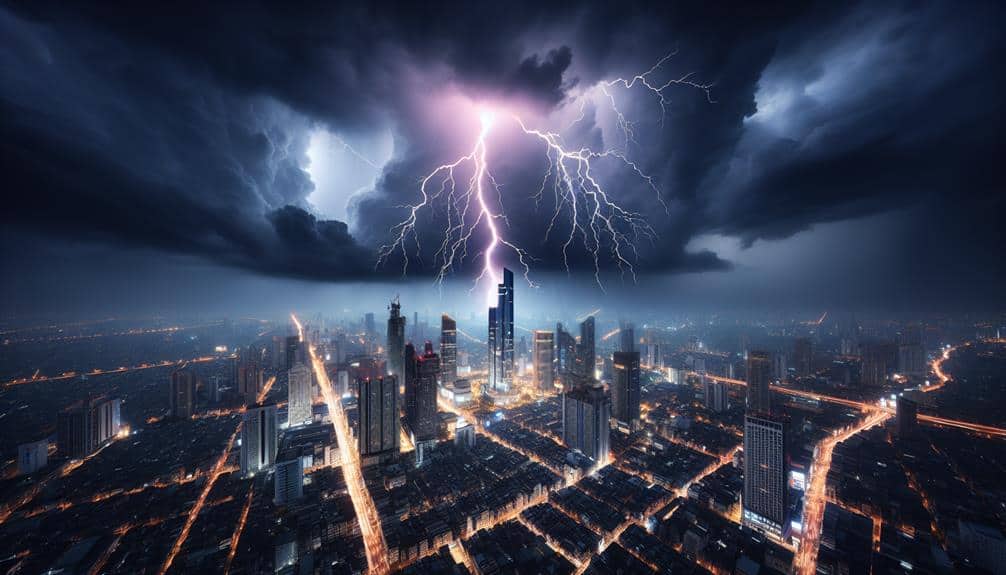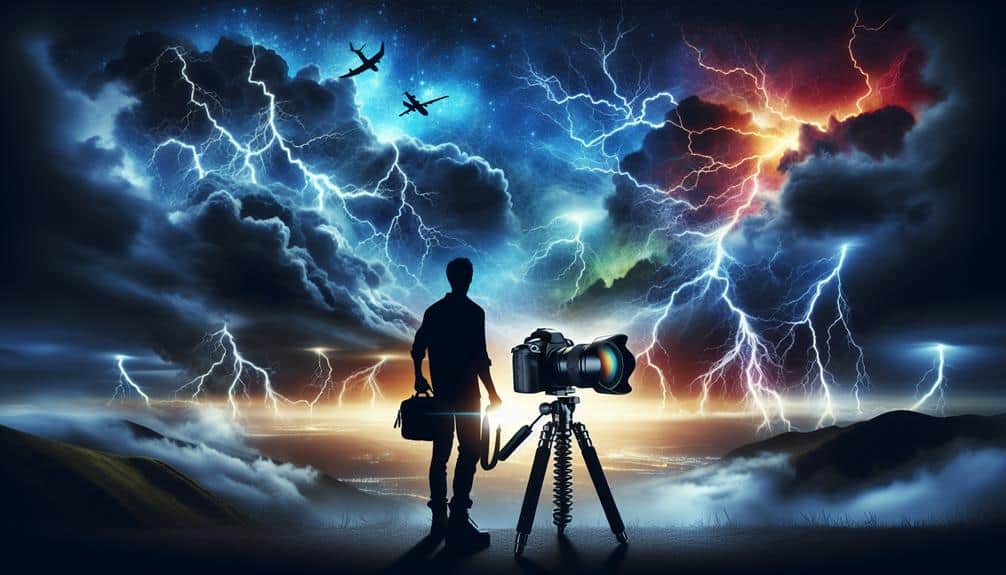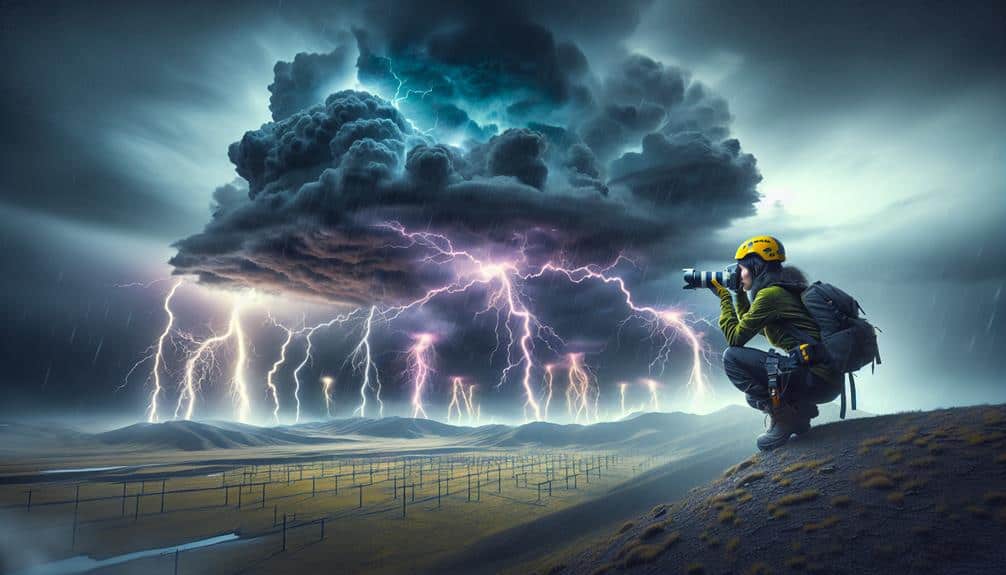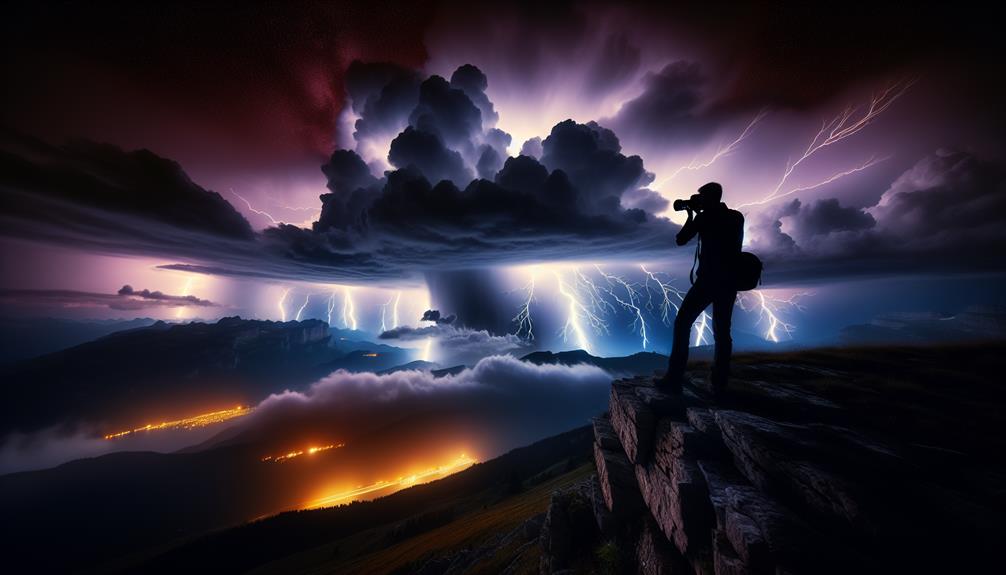We must frame our lightning photographs meticulously to enhance their visual impact and effectively convey the storm's drama and scale. Positioning the horizon lower accentuates the lightning's dominance, while including foreground elements like trees adds a sense of scale. Using the rule of thirds and leading lines creates dynamic and balanced compositions that guide the viewer's eye. Highlighting key elements and ensuring focal points capture the storm's power. Mastering these techniques not only emphasizes the expansiveness of the sky but also engages viewers by creating a compelling visual journey. If you're keen on capturing the essence of a storm, these principles are crucial.
Key Points
- Proper framing enhances the visual impact and drama of lightning photographs.
- It helps convey a sense of scale and the immensity of the storm.
- Strategic framing guides the viewer's eye to the focal points of the image.
- It balances elements within the composition, making the photograph more engaging.
Enhancing Visual Impact
By carefully framing lightning shots, we can greatly enhance their visual impact and convey a sense of awe and power. When we're out in the field, setting up our equipment, we need to think about how the elements within our frame interact. Every cloud, tree, or building can either add to or detract from the drama of the lightning.
To achieve this, let's consider the horizon. Positioning the horizon lower in the frame can make the sky, and thereby the lightning, appear more dominant and imposing. This approach not only adds drama but also helps in capturing the raw emotion of the storm.
Foreground elements play an essential role too. Including objects like silhouetted trees or structures can provide a sense of scale, emphasizing the sheer magnitude of the lightning. This technique allows us to evoke a stronger emotional response from our audience, making them feel the intensity of the scene.
Timing is everything. By anticipating the lightning strike and framing our shot in advance, we make sure that every click of the shutter captures the essence of the storm. Through thoughtful framing, we don't just take pictures — we tell compelling stories of nature's wildest moments.
Creating Balanced Compositions
While enhancing visual impact through framing, we must also focus on creating balanced compositions that draw the viewer's eye and maintain harmony within the shot. To achieve this, we can employ the rule of thirds, which divides the frame into nine equal parts using two equally spaced horizontal and vertical lines. Placing the lightning bolt or storm elements along these lines or at their intersections can create a more dynamic and engaging composition.
Perspective angles play a vital role in adding depth and dimension to our photographs. By experimenting with different vantage points, we can capture the grandeur of a lightning storm while maintaining a balanced composition. For instance, shooting from a low angle can emphasize the sky's vastness and the lightning's power.
Incorporating leading lines into our composition guides the viewer's eye towards the main subject. Roads, rivers, or even the horizon can serve as natural lines that lead to the lightning, enhancing the overall visual flow.
Additionally, negative space—areas of empty or unoccupied space—can be used strategically to create contrast and focus attention on the lightning itself. By balancing these elements, we ensure our lightning photography remains both captivating and harmonious.
Highlighting Key Elements
To highlight key elements in lightning photography, we must carefully select focal points that enhance the drama and intensity of the scene. By doing so, we make sure that the viewer's eye is drawn precisely where we want it, magnifying the awe-inspiring power of lightning.
First, let's consider lighting effects. It's vital to capture the brilliance of the lightning strike while balancing the ambient light in the scene. We can achieve this by adjusting our exposure settings to prevent overexposure and retain details in both the lightning and the landscape.
Next, composition techniques play a pivotal role. We should place key elements such as trees, buildings, or mountains in strategic positions using the rule of thirds. This not only frames the lightning effectively but also adds context to the photograph, making it more engaging.
Framing with foreground elements can introduce depth, creating a three-dimensional feel that captivates the viewer. We might use leading lines to guide the eye toward the lightning, enhancing the overall impact.
Emphasizing Scale and Distance
Capturing the sheer scale and distance of a lightning storm enhances the visual impact and provides a sense of grandeur that captivates the viewer. To achieve this, we must carefully consider depth perception and perspective. By incorporating foreground elements, such as trees or buildings, we create a size comparison that underscores the immensity of the storm. This use of spatial relationships helps us convey the vastness of the sky and the powerful reach of the lightning itself.
When we frame our shots with these elements in mind, we transform a two-dimensional image into an experience that feels expansive and immersive. Utilizing wide-angle lenses can further accentuate the perspective, making the distance between the foreground and the lightning appear even more dramatic. This technique draws the viewer into the scene, allowing them to feel the storm's magnitude.
Moreover, strategically placing the horizon line in our composition can emphasize the vertical stretch of the lightning bolt, enhancing the overall depth perception. By mastering these techniques, we can convey not just the storm's visual intensity, but also its expansive scale and the awe-inspiring distance it spans. This approach elevates our lightning photography, making each shot a tribute to nature's grandeur.
Guiding the Viewer's Eye

Skillfully directing the viewer's eye through our lightning photography demands a careful balance of composition, focal points, and lighting contrasts. We must harness these elements to establish focal points that captivate and guide the viewer's gaze seamlessly across the frame. By strategically positioning our subjects and using natural lines, we can create a visual journey that's both engaging and dynamic.
To achieve this, consider the following:
- Foreground Elements: Integrate objects like trees, buildings, or mountains in the foreground to anchor the composition and lead the viewer into the scene.
- Leading Lines: Utilize roads, rivers, or lightning bolts themselves to draw attention to specific areas, directing the viewer's eye along a deliberate path.
- Contrast and Brightness: Leverage the natural contrast between the dark sky and bright lightning strikes to highlight the most dramatic parts of the image, enhancing visual interest.
Frequently Asked Questions
What Equipment Is Essential for Capturing Lightning Photography?
To capture lightning photography, we need a sturdy tripod, a DSLR or mirrorless camera, and a remote shutter release. Lighting techniques and essential camera accessories guarantee crisp, breathtaking shots of nature's electric artistry.
How Do Weather Conditions Affect Lightning Photography?
Weather conditions greatly impact our lightning photography. Thunderstorm intensity and moisture levels dictate lightning patterns and cloud movement. By analyzing these factors, we can predict best shooting moments, capturing electrifying scenes with both technical precision and artistic vision.
What Camera Settings Work Best for Photographing Lightning?
Capturing mesmerizing lightning requires careful camera settings: a long exposure time, low ISO, and a small aperture. We achieve artistic and precise shots by balancing brightness and sharpness, ensuring each bolt is beautifully bold and brilliantly defined.
How Can Safety Be Ensured While Capturing Lightning Photos?
To guarantee our safety while capturing lightning photos, we need to prioritize safety precautions and location scouting. Emergency preparedness is essential during lightning storms; always have an exit strategy and monitor weather updates to stay safe.
What Post-Processing Techniques Enhance Lightning Photos?
We absolutely transform our lightning photos by using color correction and sharpening. Noise reduction and contrast adjustments elevate the image to new heights. With technical expertise and artistic vision, we create electrifying masterpieces that captivate every viewer.


